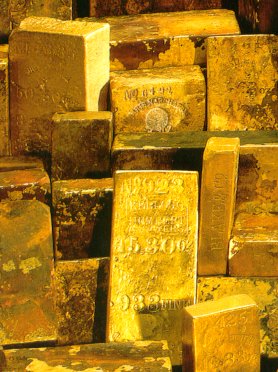Ship of Gold
Today, we hunt treasure. The University of Houston's College of Engineering presents this series about the machines that make our civilization run, and the people whose ingenuity created them.
By now you probably know about the book Rocket Boys, or the movie version, October Sky -- young Homer Hickam setting out to build his own rocket after Sputnik went up. It was a wonderful story of the hands-on creative impulse that drives good technology.
Now another such story, ten years later. Tommy Thompson emerged out of Defiance, Ohio, with the same technological verve that'd flown those rockets. Thompson built his own telephone when he was eight. In high school, he converted his car so it'd function on water as well as land.
Gary Kinder tells Thompson's remarkable story in his book Ship of Gold in the Deep Blue Sea. But he doesn't begin with Thompson. He begins instead way back in 1857 with the SS Central America, a 300-foot steamer driven by two huge paddle wheels, headed to New York from Panama with a stop at Havana. It carried 500 people on their way back from the California gold fields. Some had lost their shirts. But others were rich, and the ship was filled with gold.
A hurricane blew in as it passed 200 miles off the coast of North Carolina. The ship sprang a leak. For days, the water level rose until the ship sank. Most of the people died, and the few survivors all told poignantly terrifying stories.
That much could make a book by itself, but the adventure really begins back in the present, as Thompson goes off to study engineering at Ohio State. He's interested in underwater exploration. The dean wisely recognizes a rare genius and takes him under his wing.
Soon Tommy is going where classroom studies would never have taken him. He cuts his teeth with treasure hunters off the coast of Florida. But he sees that they have no systematic methods for finding and removing treasure. More than that, they're limited to warm, shallow water where wrecks deteriorate quickly.
Thompson's interest is in deep water, so he looks for a wreck with a lot of iron in its frame. The SS Central America fits the bill. Treasure hunters had looked for it in shallow water, but that was wishful thinking. Thompson scours newspapers and letters until he realizes it came to rest on a ridge running down into the depths below the coastal shelf. The wreck now lies in 8000 feet of water.
 For years young Thompson develops a plan, invents new deep-water robot technology, convinces backers to supply the millions of dollars needed for the work; creates a probability map based on conflicting accounts of the sinking; fights predatory searchers encroaching on his site; and, at last, sees those great iron paddle wheels emerging on cameras two miles below his ship.
For years young Thompson develops a plan, invents new deep-water robot technology, convinces backers to supply the millions of dollars needed for the work; creates a probability map based on conflicting accounts of the sinking; fights predatory searchers encroaching on his site; and, at last, sees those great iron paddle wheels emerging on cameras two miles below his ship.
So the story isn't about finding treasure after all. It's about a young man gaining an education. The treasure is an anticlimax to the story of a terrible disaster turned to gold when Tommy Thompson (like the Rocket Boys) shows us how it's still possible to create an impossible goal -- then actually reach it.
I'm John Lienhard, at the University of Houston, where we're interested in the way inventive minds work.
(Theme music)
Kinder, G., Ship of Gold in the Deep Blue Sea. New York: Vintage Books, 1999.
I am grateful to Dr. Robert Renner, Kelsey-Seybold Clinic, Houston, for strongly recommending the Kinder book.
The SS Central America had come to rest on a structure called the Blake Outer Ridge, which runs eastward down into the deep ocean off Blake Plateau, which runs along the North Carolina shore. I am grateful to Amy Huff, UH Library, for locating a map of that region of the ocean. To see it, click on MAP (and note that south is to the left, north to the right.)

Gold Bricks from the SS Central America
(from Ship of Gold in the Deep Blue Sea)